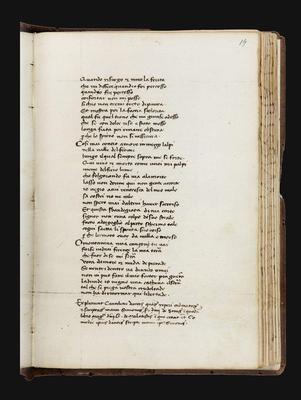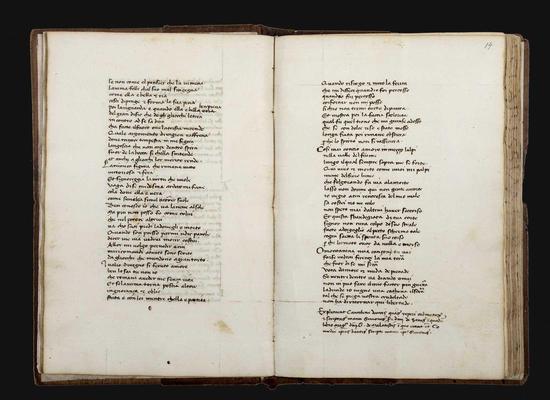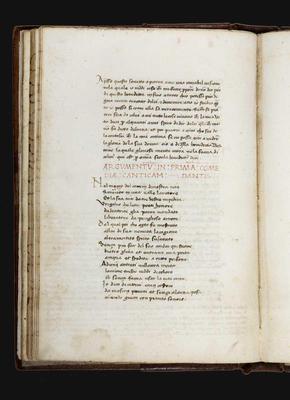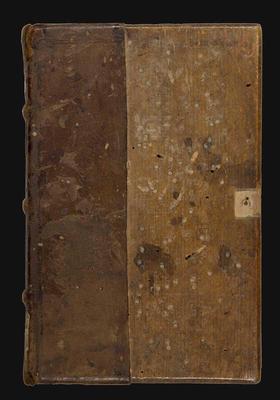Dante Alighieri
Canzoni. Vita Nuova.
Manuscript on paper. Northern Italy, mid-fifteenth century (not before 1404).Containing also: Giovanni Boccaccio, Trattatello in laude di Dante. Argomenti in terza rima su la Commedia; Simone Serdini da Siena, Four poems.
215x145 mm. 91 leaves. Eleven quires. Actual collation: 15, 210, 310, 410, 511, 65, 710, 813, 98, 104, 115(the volume has recently been resewn with the result that it is impossible to say how many leaves are missing from some quires; some leaves have been pasted onto the recto of the following leaf and their conjugates are therefore lacking). Blanks: fols. 14v, 15, 51 and 91v. Modern foliation in pencil. Text block: 137x74 mm, one column, 29-33 lines, first line above top line. Ruled in blind and plummet. Text written in brown ink, in a semi-gothic hand. The titles of the chapters, when present, are written in Latin and rubricated in red. Contemporary half-calf over wooden boards. Spine with three raised bands, label with printed shelfmark ‘P|2|1' (probably recased). In a contemporary hand the inscriptions in brown ink ‘cantilenae' on the upper edge, ‘clarissimi poetae' on the fore-edge, and ‘dantis' on the lower one. Small round holes on the panels; clasp missing. A very well preserved manuscript, thin wormholes in the gutter of the first leaves, only in two cases slightly touching the text.
Provenance: ‘Ioanes Christofarus Ceccarinus [or Ciccarinus] urbinas' (sixteenth-century ownership inscription on fols. 3v, 35r, 56v, 84v and 91v); the initials ‘S.C.' (fol. 1r); Bernard M. Rosenthal's collection (on the front pastedown ‘ms| 231'); Livio Ambrogio collection.
An important and unrecorded fifteenth-century manuscript containing a selection of Dante's texts compiled in about 1404 by the Sienese poet Simone Serdini called Il Saviozzo, following the model established by Giovanni Boccaccio in the famous codexToledano (Biblioteca Capitolar Toledo,ms104.6), in which in about 1355 he copied out different works by Dante. Serdini wrote these texts in volumes destined for his various patrons; however none of Serdini's autograph manuscripts survives.
This manuscript contains most of the so-called minor poetic works of Dante: the text of eleven of the surviving fifteen rime or canzoni, albeit with some lacunae (canzoni 1, 2, 3, and 9 are missing), and the chaptersiii-xliifrom the Vita Nuova, the work which celebrates Dante's love for Beatrice, in prose and verse, composed between ca. 1283 and 1293. In addition, the volume includes the summary in terza rima of the Commedia and the Trattatello in laude di Dante by Boccaccio, and in the last leaves four poems by Serdini himself (nos. xc, xxvi 67-169, xiii, xxv).
The colophon added by the anonymous scribe gives us some significant information:
Expliciunt Cantilene dantis quas reperi ordinatas |et scriptas manu Simonis s[er]dini desenis i[n] quoda[m] | libro mag[nifi]ci d.[omi]ni G. de malatestis i[n] quo erant et Co | medie ipsius dantis scripte manu ipsius Simonis.
This manuscript is indeed a nearly contemporary copy of a now-lost autograph written by Serdini for Galeazzo Malatesta, which the scribe states in the colophon to have personally seen in the Malatesta library (in Pesaro). Moreover, it is very similar in content to another manuscript which has been attributed to Serdini, put together for the captain Giovanni Colonna, now in the Biblioteca Laurenziana in Florence (ms 90sup.136).
With this compilation and his occasional poems Serdini became an ambassador for the cult of Dante in the courts of northern and central Italy. The present manuscript is new evidence of Serdini's active role in the transmission of Dante's works in the fifteenth century.






